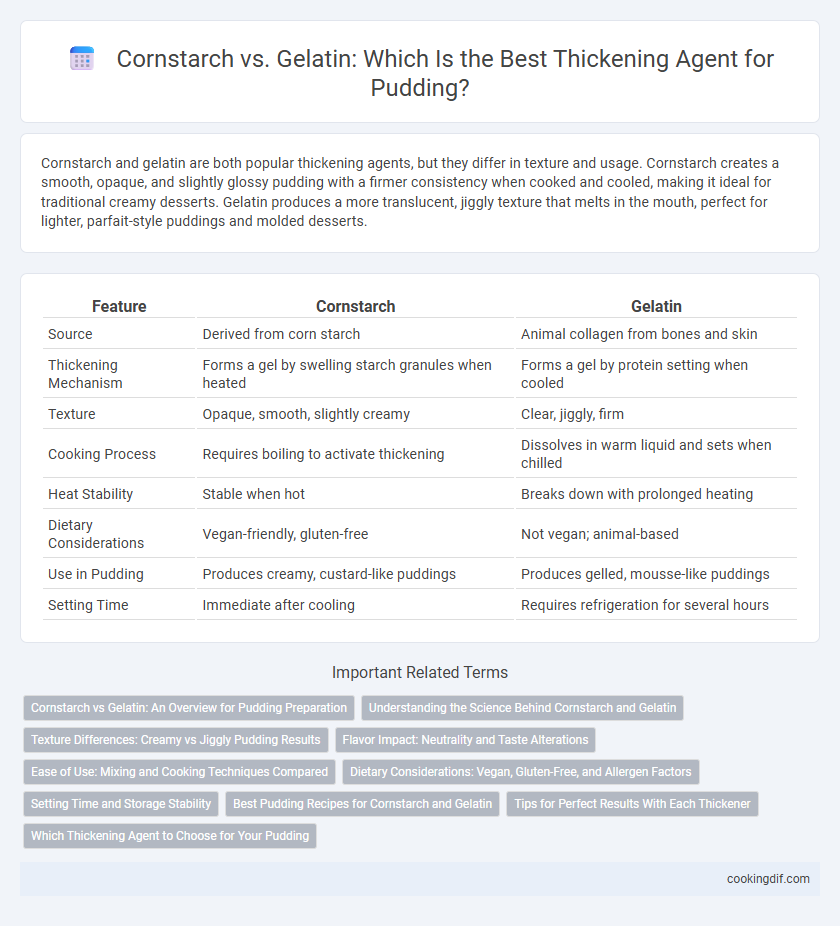Cornstarch and gelatin are both popular thickening agents, but they differ in texture and usage. Cornstarch creates a smooth, opaque, and slightly glossy pudding with a firmer consistency when cooked and cooled, making it ideal for traditional creamy desserts. Gelatin produces a more translucent, jiggly texture that melts in the mouth, perfect for lighter, parfait-style puddings and molded desserts.
Table of Comparison
| Feature | Cornstarch | Gelatin |
|---|---|---|
| Source | Derived from corn starch | Animal collagen from bones and skin |
| Thickening Mechanism | Forms a gel by swelling starch granules when heated | Forms a gel by protein setting when cooled |
| Texture | Opaque, smooth, slightly creamy | Clear, jiggly, firm |
| Cooking Process | Requires boiling to activate thickening | Dissolves in warm liquid and sets when chilled |
| Heat Stability | Stable when hot | Breaks down with prolonged heating |
| Dietary Considerations | Vegan-friendly, gluten-free | Not vegan; animal-based |
| Use in Pudding | Produces creamy, custard-like puddings | Produces gelled, mousse-like puddings |
| Setting Time | Immediate after cooling | Requires refrigeration for several hours |
Cornstarch vs Gelatin: An Overview for Pudding Preparation
Cornstarch and gelatin serve as popular thickening agents in pudding preparation, each offering distinct textures and properties. Cornstarch creates a creamy, opaque pudding by gelatinizing starch granules when heated, resulting in a smooth consistency that holds shape well when cooled. Gelatin, derived from animal collagen, provides a translucent, gel-like texture that sets firmly and melts smoothly on the palate, ideal for a more delicate pudding structure.
Understanding the Science Behind Cornstarch and Gelatin
Cornstarch thickens pudding through gelatinization, where heat causes starch granules to swell and absorb water, creating a smooth, stable texture ideal for hot or cold applications. Gelatin, a protein derived from collagen, forms a gel network as it cools, providing a creamy, elastic consistency but requires refrigeration to set properly. Understanding these molecular differences helps achieve desired pudding textures, with cornstarch offering immediate thickening and gelatin delivering a delicate, melt-in-mouth gel.
Texture Differences: Creamy vs Jiggly Pudding Results
Cornstarch creates a creamy, smooth pudding with a dense, velvety texture that holds well without wobbling. Gelatin results in a jiggly, translucent pudding characterized by its delicate, elastic consistency and firm set. Choosing cornstarch offers a rich mouthfeel, whereas gelatin emphasizes a bouncy, light texture ideal for layered or molded desserts.
Flavor Impact: Neutrality and Taste Alterations
Cornstarch provides a neutral flavor profile, allowing the pudding's original taste to shine without interference. Gelatin can impart a subtle, sometimes slightly savory aftertaste that may alter the pudding's flavor profile. Choosing cornstarch preserves the intended sweetness and richness, while gelatin might introduce a delicate change in texture and taste.
Ease of Use: Mixing and Cooking Techniques Compared
Cornstarch offers ease of use with simple mixing in cold liquids before heating, allowing pudding to thicken quickly as it cooks. Gelatin requires blooming in cold water before dissolving gently in warm liquids, which can be more time-consuming and temperature-sensitive. Cornstarch-based puddings provide more straightforward cooking techniques, ideal for consistent results without precise temperature control.
Dietary Considerations: Vegan, Gluten-Free, and Allergen Factors
Cornstarch serves as an ideal thickening agent for vegan and gluten-free pudding recipes due to its plant-based origin and absence of gluten, while gelatin, derived from animal collagen, is unsuitable for vegans and vegetarians. Both cornstarch and gelatin are generally free from common allergens like nuts, dairy, and soy, making them safe choices for most allergy-sensitive diets. Choosing cornstarch ensures a fully vegan, allergen-friendly, and gluten-free pudding without compromising texture.
Setting Time and Storage Stability
Cornstarch thickens pudding quickly, setting within minutes and providing good initial firmness, but it may lose viscosity and create syneresis during extended storage. Gelatin requires longer setting time, typically several hours in refrigeration, yet it offers superior storage stability with a smooth, elastic texture that resists weeping over time. For puddings requiring rapid preparation, cornstarch is ideal, while gelatin excels in products needing prolonged shelf life and consistent gel strength.
Best Pudding Recipes for Cornstarch and Gelatin
Cornstarch provides a smooth, creamy texture ideal for classic custard-style puddings like vanilla or chocolate, while gelatin creates a firmer, more jelly-like consistency perfect for layered or fruit-based puddings. Recipes such as traditional vanilla pudding highlight cornstarch's ability to thicken without altering flavor, whereas gelatin-rich panna cotta showcases its ability to set and hold shape. For best results, cornstarch requires careful cooking to activate its thickening properties, whereas gelatin must be dissolved and chilled to achieve optimal firmness.
Tips for Perfect Results With Each Thickener
When using cornstarch as a thickening agent for pudding, dissolve it in a cold liquid before adding to prevent lumps and cook over medium heat until the mixture reaches a full boil for maximum thickening. Gelatin requires blooming in cold water first to ensure smooth texture and must be dissolved in warm liquid without boiling to maintain its gelling strength. For best results, cornstarch yields a glossy, creamy pudding, while gelatin provides a firmer, more elastic set ideal for molded desserts.
Which Thickening Agent to Choose for Your Pudding
Cornstarch creates a smooth, glossy texture with a neutral flavor, ideal for classic, creamy puddings like vanilla or chocolate. Gelatin offers a clear, firm set and a slightly elastic texture, perfect for mousse-style or gelatin-based puddings. Choose cornstarch for thick, spoonable puddings and gelatin for jiggly, molded desserts.
Cornstarch vs gelatin for thickening agent Infographic

 cookingdif.com
cookingdif.com